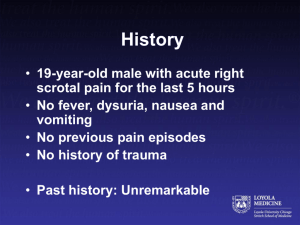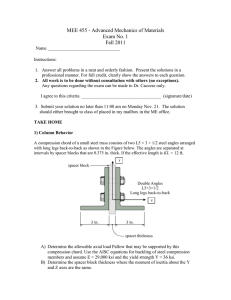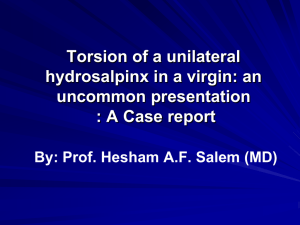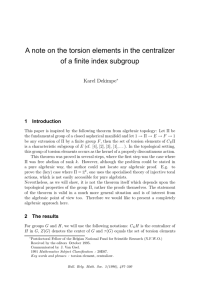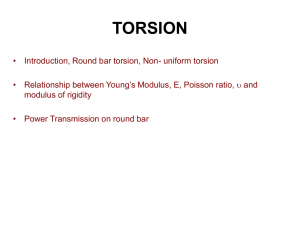The cuspidal torsion packet on hyperelliptic Fermat quotients Journal de Th´
advertisement
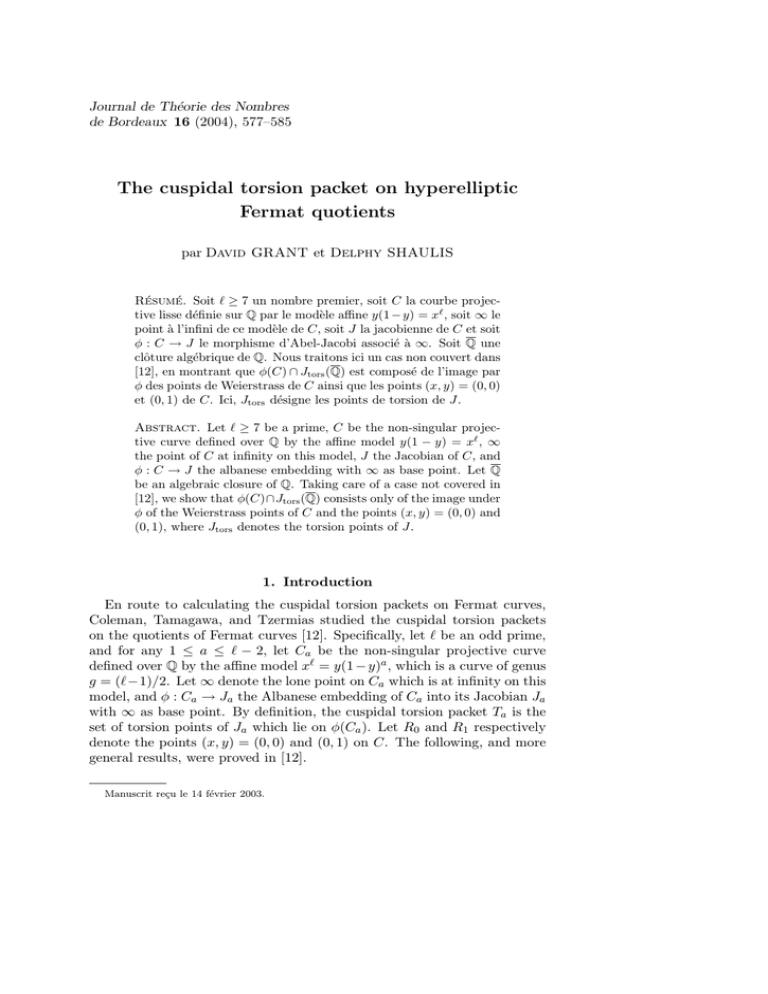
Journal de Théorie des Nombres
de Bordeaux 16 (2004), 577–585
The cuspidal torsion packet on hyperelliptic
Fermat quotients
par David GRANT et Delphy SHAULIS
Résumé. Soit ` ≥ 7 un nombre premier, soit C la courbe projective lisse définie sur Q par le modèle affine y(1 − y) = x` , soit ∞ le
point à l’infini de ce modèle de C, soit J la jacobienne de C et soit
φ : C → J le morphisme d’Abel-Jacobi associé à ∞. Soit Q une
clôture algébrique de Q. Nous traitons ici un cas non couvert dans
[12], en montrant que φ(C) ∩ Jtors (Q) est composé de l’image par
φ des points de Weierstrass de C ainsi que les points (x, y) = (0, 0)
et (0, 1) de C. Ici, Jtors désigne les points de torsion de J.
Abstract. Let ` ≥ 7 be a prime, C be the non-singular projective curve defined over Q by the affine model y(1 − y) = x` , ∞
the point of C at infinity on this model, J the Jacobian of C, and
φ : C → J the albanese embedding with ∞ as base point. Let Q
be an algebraic closure of Q. Taking care of a case not covered in
[12], we show that φ(C)∩Jtors (Q) consists only of the image under
φ of the Weierstrass points of C and the points (x, y) = (0, 0) and
(0, 1), where Jtors denotes the torsion points of J.
1. Introduction
En route to calculating the cuspidal torsion packets on Fermat curves,
Coleman, Tamagawa, and Tzermias studied the cuspidal torsion packets
on the quotients of Fermat curves [12]. Specifically, let ` be an odd prime,
and for any 1 ≤ a ≤ ` − 2, let Ca be the non-singular projective curve
defined over Q by the affine model x` = y(1 − y)a , which is a curve of genus
g = (`−1)/2. Let ∞ denote the lone point on Ca which is at infinity on this
model, and φ : Ca → Ja the Albanese embedding of Ca into its Jacobian Ja
with ∞ as base point. By definition, the cuspidal torsion packet Ta is the
set of torsion points of Ja which lie on φ(Ca ). Let R0 and R1 respectively
denote the points (x, y) = (0, 0) and (0, 1) on C. The following, and more
general results, were proved in [12].
Manuscrit reçu le 14 février 2003.
578
David Grant, Delphy Shaulis
Theorem (Coleman, Tamagawa, Tzermias). If ` ≥ 11, then there is an a,
with 1 ≤ a ≤ ` − 2, such that Ca is not hyperelliptic, and such that
Ta = {φ(∞), φ(R0 ), φ(R1 )}.
This leaves open the question of determining Ta for any fixed a and `,
and in particular, for the a for which Ca is hyperelliptic, which we address
here. It is known that Ca is hyperelliptic precisely when a = 1, (` − 1)/2,
or ` − 2. There are isomorphisms from C(`−1)/2 and C`−2 to C1 , which
induce bijections from T(`−1)/2 and T`−2 to T1 , so we will lose no generality
in concentrating on C1 . Let C = C1 , J = J1 , and T = T1 . Note that on J
the cuspidal torsion packet coincides with the hyperelliptic torsion packet.
Let ζ denote a primitive `th -root of unity, let γ be a fixed `th -root of 1/4,
and let Wi , 1 ≤ i ≤ `, denote the points (ζ i γ, 1/2) on C.
Theorem 1.1. Let ` ≥ 7. Then
T = {φ(∞), φ(R0 ), φ(R1 )} ∪ {φ(Wi )|1 ≤ i ≤ `}.
Theorem 1.1 is due to Shaulis [20]. The exposition here incorporates
some simplifications of the original argument. The case ` = 5 does not exactly fit the pattern of Theorem 1.1, and in that case T is given explicitly in
[9] and [5]. Indeed, Proposition 4.3(d) depends crucially on the assumption
that g ≥ 3.
The proof here owes heavily to the work of [12], but differs in some key
respects. In particular, it does not rely on the p-adic integration theory of
Coleman, which he used in [10] to show that Ta consists of just `-power
torsion if Ca is not hyperelliptic and ` ≥ 11, and that T consists of (2`)power torsion for ` ≥ 5. Our proof combines explicit geometry with the
action of Galois groups on torsion points, an approach to Manin-Mumford
problems that goes back to Lang [17], and has been used by many authors
since. We refer the reader to the survey article of Tzermias for the history
of the work on the Manin-Mumford Conjecture [23], and mention only some
more recent work [2], [3], [4], [6], [7], [19], [22]. For results on the torsion
of Ja that lies on a theta divisor, see [1], [13], and [21].
The next two sections of the paper are preliminary. In the first we detail
what we need about the explicit geometry of C and J, and in the second
we derive the necessary results on Galois actions on torsion points from
the theory of complex multiplication. The proof of Theorem 1.1 is given in
section 4.
We would like to thank the referee for a careful reading of this paper and
a number of useful suggestions.
2. Geometry of C and J
We assume that ` ≥ 7. Let K = Q(ζ), let K be an algebraic closure
of K, and let O = Z[ζ] denote the ring of integers of K. Let λ = 1 − ζ,
The cuspidal torsion packet on hyperelliptic Fermat quotients
579
so `O = (λ)`−1 . Note that Gal(K/Q) consists of the automorphisms σi ,
i ∈ (Z/`Z)∗ , such that σi (ζ) = ζ i .
The automorphism ξ : (x, y) → (ζx, y) of C extends to an automorphism
Ξ of J, so we can endow J with complex multiplication by O by defining an
embedding ρ : O → End(J) such that ρ(ζ) = Ξ. Since xi dx/y, 0 ≤ i ≤ g −1
forms a basis for the holomorphic differentials of C, we get immediately
(and it is well known) that the CM-type of J is Φ = {σ1 , ..., σg }. We write
[α] for ρ(α), and let + denote the group morphism on J. For any α ∈ O
we let J[α] denote the kernel of [α] in J(K) and J[α∞ ] = ∪n≥0 J[αn ], and
for any ideal a ⊆ O, we let J[a] = ∩α∈a J[α]. We identify points on J with
the corresponding divisor class in Pic0 (C). Let O denote the origin on J.
The hyperelliptic involution ι : C → C is given by ι((x, y)) = (x, 1 − y),
and its fixed points are the 2g + 2 Weierstrass points ∞ and Wi , 1 ≤ i ≤ `.
The following results are standard.
Lemma 2.1.
a) For any P on C, [−1]φ(P ) = φ(ι(P )), so [−1]∗ preserves φ(C).
b) For any P on C, [ζ]φ(P ) = φ(ξ(P )), so [ζ]∗ preserves φ(C).
c) Every point on J is represented by a unique divisor of the form
(1)
P1 + · · · + Pr − r∞
for some 0 ≤ r ≤ g, and Pi on C, 1 ≤ i ≤ r, where Pi 6= ∞, and
Pi 6= ι(Pj ) for i 6= j.
d) The points in J[2] are precisely those represented by a divisor of the
form (1), where the Pi , 1 ≤ i ≤ r, are distinct Weierstrass points.
Lemma 2.1 immediately gives the following.
Lemma 2.2. Let Q ∈ J be represented by a divisor as in (1), and let
φ(C)Q denote the image of φ(C) under the translation-by-Q map. Then
φ(C)∩φ(C)Q is empty if r ≥ 3, is {φ(P1 ), φ(P2 )} if r = 2, and is {φ(P1 ), O}
if r = 1.
Indeed, if φ(P ) = Q + φ(P 0 ), then P + ι(P 0 ) − 2∞ and P1 + ... + Pr − r∞
represent the same point in J, which by Lemma 2.1 is impossible for r ≥ 3,
which implies that P is P1 or P2 for r = 2, and that P is P1 or O for r = 1.
Recall that a point Q ∈ J(K) is called almost rational over K, in the
sense of Ribet [4], [19], if whenever τ (Q) + υ(Q) = [2]Q for some τ, υ ∈
Gal(K/K), then we have τ (Q) = υ(Q) = Q. We get the following from
Lemma 2.1 and the fact that ∞ is K-rational.
Lemma 2.3.
a) The curve φ(C), and in particular the torsion packet
T , are preserved under the action of Gal(K/K).
b) Every Q ∈ φ(C) − J[2] is almost rational over K.
We will need the following, which is Proposition C in [6].
David Grant, Delphy Shaulis
580
Lemma 2.4. Let k be a perfect field, G be a commutative algebraic group
over k, and Ω be a finite set of primes. Let GΩ denote the torsion points of
G whose order is divisible only by primes in Ω, and Σ denote the subset of
almost rational torsion points of G overQ
k in GΩ . For an odd prime p, set
δ(p) = 1, and set δ(2) = 2. Define A = p∈Ω pδ(p) . Let k1 = k(G[A]), and
suppose that there exist an integer B, divisible only by primes in Ω, such
that G(k1 ) ∩ GΩ ⊆ G[B]. Then Σ ⊆ G[B].
Since the orders of the poles of x and y at ∞ are respectively 2 and `,
we see that for P on C, φ(P ) ∈ J[`] − O if and only if there is a function on
C of the form y + f (x), where f is a polynomial of degree at most g, whose
divisor is `(P − ∞). If this is the case, then the divisor of 1 − y + f (x) is
`(ι(P ) − ∞), so comparing divisors and matching up coefficients of x` gives
(y + f (x))(1 − y + f (x)) = (x − x(P ))` .
Lemma 2.5. #(φ(C) ∩ (J[`] − O)) ≤ ` + 2.
Proof. The only points P on C with x(P ) = 0 are R0 and R1 , and considering the divisors of y and 1 − y shows that φ(R0 ), φ(R1 ) ∈ J[`] − O.
Furthermore, if φ((z, w)) ∈ J[`] − O with z 6= 0, we get that φ((ζ i z, w)) are
distinct points in J[`] − O for i ∈ Z/`Z. So it suffices to show that there
are not two points (z, w) and (r, s) on C, with zr 6= 0 and z ` 6= r` , such
that φ((z, w)), φ((r, s)) ∈ J[`] − O.
If such (z, w) and (r, s) exist, then there are polynomials f and h of
degree at most g such that
(y + f (x))(1 − y + f (x)) = (x − z)` , (y + h(x))(1 − y + h(x)) = (x − r)` .
Simplifying these gives
(2)
x` + f (x) + f (x)2 = (x − z)` , x` + h(x) + h(x)2 = (x − r)` .
Substituting x = zX and dividing by z ` in the former equation of (2), and
substituting x = rX and dividing by r` in the latter equation of (2), gives
two expressions for (X − 1)` . Equating these yields
(3)
r` f (zX)(f (zX) + 1) = z ` h(rX)(h(rX) + 1).
Letting u and v be square roots of z ` and r` , (3) can be rewritten as
(4)
z ` − r` = (u(2h(rX) + 1) + v(2f (zX) + 1))(u(2h(rX) + 1) − v(2f (zX) + 1)).
By assumption z ` − r` 6= 0, so we get from (4) that u(2h(rX) + 1) ±
v(2f (zX) + 1) are both constant polynomials, hence that f (x) and h(x)
are both constants. But by (2) this violates the assumption that zr 6= 0. The cuspidal torsion packet on hyperelliptic Fermat quotients
581
3. Galois actions on torsion points
Let H be the Hilbert class field of K. Recall that by using cyclotomic
units, one can see that every principal ideal of O prime to (λ) has a generator congruent to 1 mod λ2 . Therefore, by Artin reciprocity, H is also
the ray class field of K of conductor (λ)2 (so also the ray class field of K
of conductor (λ)).
√
Let E = K(γ) and L = E( λ). Recall that C has good reduction at
every rational prime p 6= `, and it is shown in [11] that C, and hence J,
achieves everywhere good reduction over L. For any extension of number
fields F1 /F2 , let D(F1 /F2 ) denote the discriminant of F1 /F2 , and NFF21
denote the norm from F1 to F2 . If F1 /F2 is a Galois extension, let GF1 /F2
denote the Galois group of F1 /F2 . Finally, if F1 /F2 is an abelian extension,
let f(F1 /F2 ) denote the conductor of F1 /F2 .
Lemma 3.1. We have ord(λ) (f(E/K)) ≤ 2.
Proof. This is a well-known argument that we briefly recall. The analogue
to elliptic curves with complex multiplication plays a key role in the proof
of the Coates-Wiles theorem (see [8], [15]).
If E/K is unramified over (λ) there is nothing to prove, so suppose it is
ramified. Then it is totally ramified over (λ), so Q(γ)/Q is totally ramified
over `. Hence ord` (D(Q(γ)/Q)) ≥ `. But for any r ∈ Q, the polynomial
discriminant of x` − r is ±r`−1 `` , so ord` (D(Q(γ)/Q)) = `. Calculating
the discriminant of E/Q two ways shows that NQK (D(E/K))D(K/Q)` =
Q(γ)
NQ (D(E/Q(γ)))D(Q(γ)/Q)`−1 . The order at ` of the right-hand side is
(` − 2) + `(` − 1), so the order at ` of NQK (D(E/K)) is 2(` − 1). Hence
ord(λ) (D(E/K)) = 2(` − 1). Since all non-trivial characters on GE/K have
the same conductor, the conductor-discriminant formula applied to E/K
now gives the result.
Lemma 3.2. For any m and n coprime in Z, H(J[m∞ ]) and H(J[n∞ ])
are linearly disjoint over H.
Proof. Let M = H(J[m∞ ])∩H(J[n∞ ]). By the theory of complex multiplication, M is abelian over K, and by the criterion of Néron-Ogg-Shafarevich,
since m and n are coprime, M/K is ramified only over (λ), so M/H is totally ramified at every prime over (λ). For the same reason, M L/L is
unramified, so the ramification index over K of any prime of M L above
(λ) divides [L : K] = 2`. Hence [M : H] divides 2`. Our goal is to show
[M : H] = 1.
Suppose for a contradiction that 2|[M : H], so M/H has a quadratic
subextension M 0 /H. Then since M 0 is totally ramified at every prime of
H above (λ), D(M 0 /H) = (λ). Since H/K is unramified, if h is the class
582
David Grant, Delphy Shaulis
number of K, D(M 0 /K) = (λ)h . So the conductor-discriminant formula
applied to M 0 /K gives that
Y
(5)
(λh ) =
fχ
χ∈ĜM 0 /K
where fχ is the conductor of the fixed field of χ over K. Note that fχ is
trivial if and only if the fixed field of χ is contained in H, which happens
if and only if χ factors through GM 0 /K /GM 0 /H ∼
= GH/K . Therefore fχ is
non-trivial for precisely h = [H : K] choices of χ, and by (5), for each of
these, fχ = (λ). Hence the conductor of M 0 /K is also (λ). Since the ray
class field of K of conductor (λ) is H, no such M 0 exists, and [M : H]
divides `.
Finally suppose for a contradiction that [M : H] = `. Then since M L/L
is unramified, the same must be true of M E/E. Therefore M E = EI,
where I is the inertia subfield in M E of any prime of M E above (λ).
Since (λ) does not divide f(I/K), the formula for conductors of composite
extensions and Lemma 3.1 imply that ord(λ) (f(M E/K)) ≤ 2. Hence M is
contained in the ray class field of K of conductor (λ)2 , which is H.
If p is a rational prime, for every x in the p-adic integers Zp and u ∈ J[pn ],
we define [x]u = [xn ]u, where xn ∈ Z is such that x ≡ xn mod pn .
Lemma 3.3. Let p 6= ` be a rational prime. Then for every x ∈ Z∗p , there
is a τx ∈ Gal(K/H) such that τx (u) = [x]u for every u ∈ J[p∞ ].
Proof. Since J has good reduction at p, it follows from Theorem 2.8 of
Chapter 4 of [18] that Gal(H(J[p∞ ])/H) is isomorphic to NΦ0 ((Op )∗ ), where
Op is the inverse limit as n goes to infinity of O/pnQ
, and NΦ0 denotes the
reflex norm (that is, for any α ∈ K, NΦ0 (α) = σ∈Φ σ −1 (α).) If =
ζ + ζ −1 , then Z[] is the ring of integers of K0 = K(), and since Φ is a
set of representatives for the orbits of GK/Q under the action of complex
conjugation, the reflex norm restricted to K0 is just the norm NQK0 . Then
NQK0 induces a norm map N : Z[]∗p → Z∗p , so it suffices to show that there is
a y ∈ Z[]∗p such that x = N (y). But via the Chinese Remainder Theorem,
if p1 ,...,pr are the primes of K0 above p, then we have an isomorphism
ψ : Z[]∗p → ⊕ri=1 Z[]∗pi , where Z[]pi is the valuation ring in (K0 )pi , the
completion of K0 at pi . Furthermore, (K0 )p1 /Qp is an unramified extension
of complete local fields and x is a unit in Zp , so there is a z ∈ Z[]∗p1 whose
norm from (K0 )p1 to Qp is x. We can then take y such that ψ(y) =
(z, 1, ..., 1), and we will have N (y) = x.
Lemma 3.4. There is a τ ∈ Gal(K/K) such that τ (u) = [1 + `]u for all
u ∈ J[`∞ ].
The cuspidal torsion packet on hyperelliptic Fermat quotients
583
Indeed, it is stated in the proof of Proposition 2 in [12] that there is such
a τ ∈ Gal(K/Q), but the construction there shows that τ fixes K. It is
also stated in [12] only for ` ≥ 11, but the same proof holds for ` = 7.
4. Proof of Theorem 1.1
Suppose t ∈ T . If t = O, then t = φ(∞), so from now on we assume
t 6= O. We can uniquely write
t = t2 + tλ + t 0 ,
where t2 ∈ J[2∞ ], tλ ∈ J[λ∞ ], and t0 is of order prime to 2λ.
Theorem 1.1 will follow directly from Propositions 4.1, 4.2, and 4.3.
Proposition 4.1. We have t0 = O.
Proof. Let t0 have order r. By applying Lemmas 3.2 and 3.3 to every prime
dividing r, there exist a τ ∈ Gal(K/H) such that τ (t0 ) = [2]t0 . Furthermore,
applying Lemma 3.2 with m = 2` and n = r, we can further assume that τ
fixes t2 and tλ . Hence τ 2 (t) + t + t = τ (t) + τ (t) + τ (t), and t, τ (t), τ 2 (t) are
all in φ(C) by Lemma 2.3. By Lemma 2.1, either τ (t) ∈ J[2], or t = τ (t).
In either case, t0 = O.
Proposition 4.2. If t2 6= O, then tλ = O, and t = t2 = φ(Wi ), for some
1 ≤ i ≤ `.
Proof. Since t2 6= O, we claim that there is a τ ∈ Gal(K/H) such that
τ (t2 ) = t2 + v, for some v ∈ J[2] − O. Indeed, let 2n be the smallest
power of 2 such that [2n ]t2 = O, so n ≥ 1. If n ≥ 2, from Lemma 3.3
we can let τ be an element such that τ (t2 ) = [1 + 2n−1 ]t2 . Suppose now
that n = 1. Lemma 2.1 shows that H(J[2]) = H(γ), which is a non-trivial
extension of H since (2) is unramified in H. If β is any non-trivial element
in Gal(H(γ)/H), then β(t2 ) = [ζ j ]t2 for some 1 ≤ j ≤ ` − 1. Hence in this
case we can take τ = β.
From Lemma 3.2, we can further assume that τ fixes tλ . Then τ (t) =
t+v, so τ (t) ∈ φ(C)∩φ(C)v . Lemmas 2.1 and 2.2 now imply that t = φ(Wi )
for some 1 ≤ i ≤ `.
Proposition 4.3. If t2 = O, then t = tλ and
a) J(K(J[`])) ∩ J[`∞ ] ⊆ J[`].
b) t ∈ J[`].
c) t ∈ J[λ3 ].
d) t ∈ J[λ].
e) t = φ(R0 ) or t = φ(R1 ).
Proof.
a) Suppose y ∈ J(K(J[`])) ∩ J[`∞ ]. By Lemma 3.4, there is a
τ ∈ Gal(K/K) such that τ (x) = [1 + `]x for every x ∈ J[`∞ ]. Hence
τ fixes K(J[`]), so τ (y) = y. Therefore y ∈ J[`].
584
David Grant, Delphy Shaulis
b) Lemma 2.3 shows that t ∈ J[`∞ ] is almost rational over K. Taking
Ω = {`}, G = J, and k = K in Lemma 2.4, then part (a) gives that
t ∈ J[`].
c) Making use of results of Greenberg [14] and Kurihara [16], Lemma 2
of [12] gives that if t ∈ J[`] − J[λ3 ], then #(φ(C) ∩ J[`]) ≥ `2 . The
proof there is stated for ` ≥ 11 but works equally well for ` = 7. This
violates Lemma 2.5, so t ∈ J[λ3 ].
d) This is Proposition 4 of [12] for ` ≥ 11, and in the hyperelliptic
case is easy to do directly for any ` ≥ 7. Indeed, if t ∈ J[λ3 ], then
[(1 + ζ)(1 − ζ)3 ]t = O. Multiplying this out gives t + [ζ 3 ]t + [ζ 3 ]t =
[ζ]t + [ζ]t + [ζ 4 ]t, so by Lemma 2.1, either [ζ 3 ]t ∈ J[2], t = [−ζ 3 ]t,
t = [ζ]t, or t = [ζ 4 ]t. The first two possibilities give a contradiction,
and the other possibilities imply that t ∈ J[λ].
e) Note that J[λ] = O ∪∪gi=1 {[i]φ(R0 ), [i]φ(R1 )}. The result now follows
from Lemma 2.1.
References
[1] G. Anderson, Torsion points on Jacobians of quotients of Fermat curves and p-adic soliton
theory. Invent. Math 118, (1994), 475–492.
[2] M. Baker, Torsion points on modular curves. Invent. Math 140, (2000), 487–509.
[3] M. Baker, B. Poonen, Torsion packets on curves. Compositio Math 127, (2001), 109–116.
[4] M. Baker, K. Ribet, Galois theory and torsion points on curves. Journal de Théorie des
nombres de Bordeaux 15, (2003), 11–32.
[5] J. Boxall, D. Grant, Examples of torsion points on genus 2 curves. Trans. Amer. Math.
Soc 352, (2000), 4533–4555.
[6] J. Boxall, D. Grant, Singular torsion on elliptic curves. Mathematical Research Letters
10, (2003), 847–866.
[7] F. Calegari, Almost rational torsion points on semistable elliptic curves. IMRN no. 10,
(2001), 487–503.
[8] J. Coates, A. Wiles, On the conjecture of Birch and Swinnerton-Dyer. Invent. Math 39,
(1977), 223–251.
[9] R. F. Coleman, Torsion points on Fermat curves. Compositio Math 58, (1986), 191–208.
[10] R. F. Coleman , Torsion points on abelian étale coverings of P1 − {0, 1, ∞}. Trans. AMS
311, (1989), 185–208.
[11] R. F. Coleman, W. McCallum, Stable reduction of Fermat curves and Jacobi sum Hecke
characters J. Reine Angew. Math 385, (1988), 41–101.
[12] R. F. Coleman, A. Tamagawa, P. Tzermias, The cuspidal torsion packet on the Fermat
curve. J. Reine Angew. Math 496, (1998), 73–81.
[13] D. Grant, Torsion on theta divisors of hyperelliptic Fermat jacobians. Compositio Math.
140, (2004), 1432–1438.
[14] R. Greenberg, On the Jacobian variety of some algebraic curves. Compositio Math 42,
(1981), 345–359.
[15] R. Gupta, Ramification in the Coates-Wiles tower. Invent. Math 81, (1985), 59–69.
[16] M. Kurihara, Some remarks on conjectures about cyclotomic fields and K-groups of Z.
Composition Math 81, (1992), 223–236.
[17] S. Lang, Division points on curves. Ann. Mat. Pura. Appl 70, (1965), 229-234.
[18] S. Lang, Complex Multiplication. Springer-Verlag, New York, 1983.
The cuspidal torsion packet on hyperelliptic Fermat quotients
585
[19] K. Ribet, M. Kim, Torsion points on modular curves and Galois theory. Notes of a talk by
K. Ribet in the Distinguished Lecture Series, Southwestern Center for Arithmetic Algebraic
Geometry, (May 1999).
[20] D. Shaulis, Torsion points on the Jacobian of a hyperelliptic rational image of a Fermat
curve. Thesis, University of Colorado at Boulder, 1998.
[21] B. Simon, Torsion points on a theta divisor in the Jacobian of a Fermat quotient. Thesis,
University of Colorado at Boulder, 2003.
[22] A. Tamagawa, Ramification of torsion points on curves with ordinary semistable Jacobian
varieties. Duke Math. J 106, (2001), 281–319.
[23] P. Tzermias, The Manin-Mumford conjecture: a brief survey. Bull. London Math. Soc. 32,
(2000), 641–652.
David Grant
Department of Mathematics
University of Colorado at Boulder
Boulder, CO 80309-0395 USA
E-mail : grant@boulder.colorado.edu
Delphy Shaulis
Department of Mathematics
University of Colorado at Boulder
Boulder, CO 80309-0395 USA
E-mail : shaulis@euclid.colorado.edu

